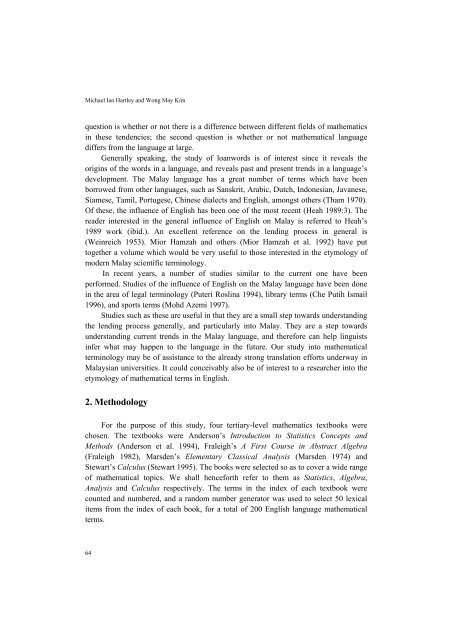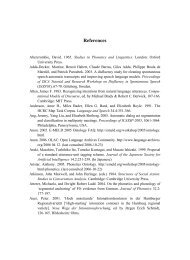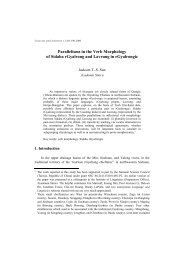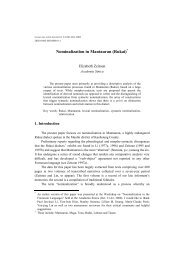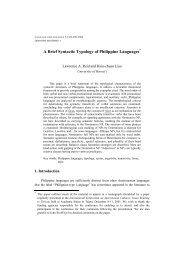Loanwords from English to Malay in the Field of Mathematics*
Loanwords from English to Malay in the Field of Mathematics*
Loanwords from English to Malay in the Field of Mathematics*
You also want an ePaper? Increase the reach of your titles
YUMPU automatically turns print PDFs into web optimized ePapers that Google loves.
Michael Ian Hartley and Wong May Kim<br />
question is whe<strong>the</strong>r or not <strong>the</strong>re is a difference between different fields <strong>of</strong> ma<strong>the</strong>matics<br />
<strong>in</strong> <strong>the</strong>se tendencies; <strong>the</strong> second question is whe<strong>the</strong>r or not ma<strong>the</strong>matical language<br />
differs <strong>from</strong> <strong>the</strong> language at large.<br />
Generally speak<strong>in</strong>g, <strong>the</strong> study <strong>of</strong> loanwords is <strong>of</strong> <strong>in</strong>terest s<strong>in</strong>ce it reveals <strong>the</strong><br />
orig<strong>in</strong>s <strong>of</strong> <strong>the</strong> words <strong>in</strong> a language, and reveals past and present trends <strong>in</strong> a language’s<br />
development. The <strong>Malay</strong> language has a great number <strong>of</strong> terms which have been<br />
borrowed <strong>from</strong> o<strong>the</strong>r languages, such as Sanskrit, Arabic, Dutch, Indonesian, Javanese,<br />
Siamese, Tamil, Portugese, Ch<strong>in</strong>ese dialects and <strong>English</strong>, amongst o<strong>the</strong>rs (Tham 1970).<br />
Of <strong>the</strong>se, <strong>the</strong> <strong>in</strong>fluence <strong>of</strong> <strong>English</strong> has been one <strong>of</strong> <strong>the</strong> most recent (Heah 1989:3). The<br />
reader <strong>in</strong>terested <strong>in</strong> <strong>the</strong> general <strong>in</strong>fluence <strong>of</strong> <strong>English</strong> on <strong>Malay</strong> is referred <strong>to</strong> Heah’s<br />
1989 work (ibid.). An excellent reference on <strong>the</strong> lend<strong>in</strong>g process <strong>in</strong> general is<br />
(We<strong>in</strong>reich 1953). Mior Hamzah and o<strong>the</strong>rs (Mior Hamzah et al. 1992) have put<br />
<strong>to</strong>ge<strong>the</strong>r a volume which would be very useful <strong>to</strong> those <strong>in</strong>terested <strong>in</strong> <strong>the</strong> etymology <strong>of</strong><br />
modern <strong>Malay</strong> scientific term<strong>in</strong>ology.<br />
In recent years, a number <strong>of</strong> studies similar <strong>to</strong> <strong>the</strong> current one have been<br />
performed. Studies <strong>of</strong> <strong>the</strong> <strong>in</strong>fluence <strong>of</strong> <strong>English</strong> on <strong>the</strong> <strong>Malay</strong> language have been done<br />
<strong>in</strong> <strong>the</strong> area <strong>of</strong> legal term<strong>in</strong>ology (Puteri Rosl<strong>in</strong>a 1994), library terms (Che Putih Ismail<br />
1996), and sports terms (Mohd Azemi 1997).<br />
Studies such as <strong>the</strong>se are useful <strong>in</strong> that <strong>the</strong>y are a small step <strong>to</strong>wards understand<strong>in</strong>g<br />
<strong>the</strong> lend<strong>in</strong>g process generally, and particularly <strong>in</strong><strong>to</strong> <strong>Malay</strong>. They are a step <strong>to</strong>wards<br />
understand<strong>in</strong>g current trends <strong>in</strong> <strong>the</strong> <strong>Malay</strong> language, and <strong>the</strong>refore can help l<strong>in</strong>guists<br />
<strong>in</strong>fer what may happen <strong>to</strong> <strong>the</strong> language <strong>in</strong> <strong>the</strong> future. Our study <strong>in</strong><strong>to</strong> ma<strong>the</strong>matical<br />
term<strong>in</strong>ology may be <strong>of</strong> assistance <strong>to</strong> <strong>the</strong> already strong translation efforts underway <strong>in</strong><br />
<strong>Malay</strong>sian universities. It could conceivably also be <strong>of</strong> <strong>in</strong>terest <strong>to</strong> a researcher <strong>in</strong><strong>to</strong> <strong>the</strong><br />
etymology <strong>of</strong> ma<strong>the</strong>matical terms <strong>in</strong> <strong>English</strong>.<br />
2. Methodology<br />
For <strong>the</strong> purpose <strong>of</strong> this study, four tertiary-level ma<strong>the</strong>matics textbooks were<br />
chosen. The textbooks were Anderson’s Introduction <strong>to</strong> Statistics Concepts and<br />
Methods (Anderson et al. 1994), Fraleigh’s A First Course <strong>in</strong> Abstract Algebra<br />
(Fraleigh 1982), Marsden’s Elementary Classical Analysis (Marsden 1974) and<br />
Stewart’s Calculus (Stewart 1995). The books were selected so as <strong>to</strong> cover a wide range<br />
<strong>of</strong> ma<strong>the</strong>matical <strong>to</strong>pics. We shall henceforth refer <strong>to</strong> <strong>the</strong>m as Statistics, Algebra,<br />
Analysis and Calculus respectively. The terms <strong>in</strong> <strong>the</strong> <strong>in</strong>dex <strong>of</strong> each textbook were<br />
counted and numbered, and a random number genera<strong>to</strong>r was used <strong>to</strong> select 50 lexical<br />
items <strong>from</strong> <strong>the</strong> <strong>in</strong>dex <strong>of</strong> each book, for a <strong>to</strong>tal <strong>of</strong> 200 <strong>English</strong> language ma<strong>the</strong>matical<br />
terms.<br />
64


